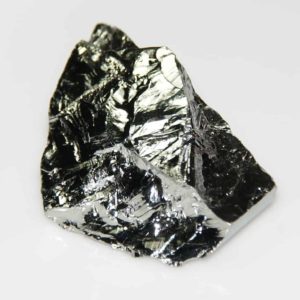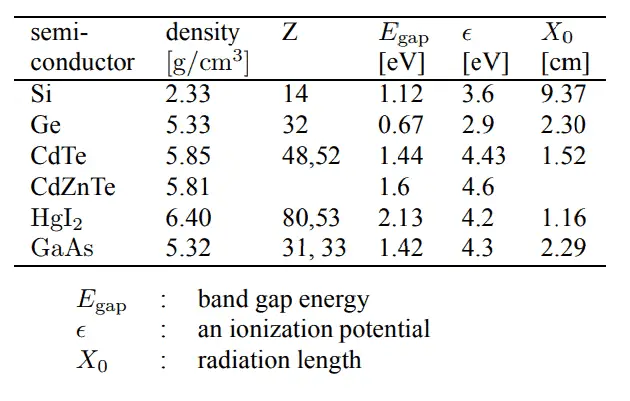
In general, semiconductors are materials, inorganic or organic, which have the ability to control their conduction depending on chemical structure, temperature, illumination, and presence of dopants. The name semiconductor comes from the fact that these materials have an electrical conductivity between that of a metal, like copper, gold, etc. and an insulator, such as glass. They have an energy gap less than 4eV (about 1eV). In solid-state physics, this energy gap or band gap is an energy range between valence band and conduction band where electron states are forbidden. In contrast to conductors, electrons in a semiconductor must obtain energy (e.g. from ionizing radiation) to cross the band gap and to reach the conduction band. Properties of semiconductors are determined by the energy gap between valence and conduction bands.
Semiconductor Materials
There are many types of semiconductors in nature and others synthesized in laboratories; however, the best known are silicon (Si) and germanium (Ge).
Types of semiconductors:
-

Purified silicon. Source: wikipedia.org License: Public Domain Silicon. Silicon is a chemical element with atomic number 14 which means there are 14 protons and 14 electrons in the atomic structure. The chemical symbol for Silicon is Si. Silicon is a hard and brittle crystalline solid with a blue-grey metallic lustre, it is a tetravalent metalloid and semiconductor. Silicon is mainly used for charged particle detectors (especially for tracking charged particles) and soft X-ray detectors. The large band-gap energy (Egap= 1.12 eV) allows us to operate the detector at room temperature, but cooling is prefered to reduce noise. Silicon based detectors are very important in high-energy physics. Since silicon-based detectors are very good for tracking charged particles, they constitute a substantial part of detection system at the LHC in CERN.
-

12 grams polycrystalline germanium. Source: wikipedia.org License: CC BY 3.0 Germanium. Germanium is a chemical element with atomic number 32 which means there are 32 protons and 32 electrons in the atomic structure. The chemical symbol for Germanium is Ge. Germanium is a lustrous, hard, grayish-white metalloid in the carbon group, chemically similar to its group neighbors tin and silicon. Pure germanium is a semiconductor with an appearance similar to elemental silicon. Germanium is widely used for gamma ray spectroscopy. In gamma spectroscopy, germanium is preferred due to its atomic number being much higher than silicon and which increases the probability of gamma ray interaction. Germanium is more used than silicon for radiation detection because the average energy necessary to create an electron-hole pair is 3.6 eV for silicon and 2.9 eV for germanium, which provides the latter a better resolution in energy. On the other hand, germanium has a small band gap energy (Egap = 0.67 eV), which requires to operate the detector at cryogenic temperatures.
- Diamond. Diamond is a solid form of the element carbon with its atoms arranged in a crystal structure called diamond cubic. Diamonds are also very good electrical insulators which strangely is both useful and problematic for electrical devices. Diamond is a wide-band gap semiconductor (Egap= 5.47 eV) with high potential as an electronic device material in many devices. Diamond detectors have many similarities with silicon detectors, but are expected to offer significant advantages, in particular a high radiation hardness and very low drift currents.
 CdTe and CdZnTe. Cadmium telluride (CdTe) and cadmium zinc telluride (CdZnTe) have been regarded as promising semiconductor materials for hard X-ray and gamma ray detection. The high atomic number and the high density of these materials mean they can effectively attenuate X-rays and gamma rays with energies of greater than 20 keV that traditional silicon-based sensors are unable to detect. This significantly increases their quantum efficiency in comparison with silicon-based . The large band-gap energy (Egap= 1.44 eV) allows us to operate the detector at room temperature. On the other hand, a considerable amount of charge loss in these detectors produces a reduced energy resolution.
CdTe and CdZnTe. Cadmium telluride (CdTe) and cadmium zinc telluride (CdZnTe) have been regarded as promising semiconductor materials for hard X-ray and gamma ray detection. The high atomic number and the high density of these materials mean they can effectively attenuate X-rays and gamma rays with energies of greater than 20 keV that traditional silicon-based sensors are unable to detect. This significantly increases their quantum efficiency in comparison with silicon-based . The large band-gap energy (Egap= 1.44 eV) allows us to operate the detector at room temperature. On the other hand, a considerable amount of charge loss in these detectors produces a reduced energy resolution.
Pure Semiconductor
An intrinsic semiconductor is completely pure semiconductor without any significant dopant species present. Therefore, intrinsic semiconductors are also known as pure semiconductors or i-type semiconductors.
![]() The number of charge carriers at certain temperature is therefore determined by the properties of the material itself instead of the amount of impurities. Note that, a 1 cm3 sample of pure germanium at 20 °C contains about 4.2×1022 atoms, but also contains about 2.5 x 1013 free electrons and 2.5 x 1013 holes. These charge carriers are produced by thermal excitation. In intrinsic semiconductors, the number of excited electrons and the number of holes are equal: n = p. Electrons and holes are created by excitation of electron from valence band to the conduction band. An electron hole (often simply called a hole) is the lack of an electron at a position where one could exist in an atom or atomic lattice. This equality may even be the case after doping the semiconductor, though only if it is doped with both donors and acceptors equally. In this case, n = p still holds, and the semiconductor remains intrinsic, though doped.
The number of charge carriers at certain temperature is therefore determined by the properties of the material itself instead of the amount of impurities. Note that, a 1 cm3 sample of pure germanium at 20 °C contains about 4.2×1022 atoms, but also contains about 2.5 x 1013 free electrons and 2.5 x 1013 holes. These charge carriers are produced by thermal excitation. In intrinsic semiconductors, the number of excited electrons and the number of holes are equal: n = p. Electrons and holes are created by excitation of electron from valence band to the conduction band. An electron hole (often simply called a hole) is the lack of an electron at a position where one could exist in an atom or atomic lattice. This equality may even be the case after doping the semiconductor, though only if it is doped with both donors and acceptors equally. In this case, n = p still holds, and the semiconductor remains intrinsic, though doped.
Semiconductors have an energy gap less than 4eV (about 1eV). Band gaps are naturally different for different materials. For example, diamond is a wide-band gap semiconductor (Egap= 5.47 eV) with high potential as an electronic device material in many devices. On the other side, germanium has a small band gap energy (Egap = 0.67 eV), which requires to operate the detector at cryogenic temperatures. In solid-state physics, this energy gap or band gap is an energy range between valence band and conduction band where electron states are forbidden. In contrast to conductors, electrons in a semiconductor must obtain energy (e.g. from ionizing radiation) to cross the band gap and to reach the conduction band.
Intrinsic semiconductors, however, are not very useful, as they are neither very good insulators nor very good conductors. However, one important feature of semiconductors is that their conductivity can be increased and controlled by doping with impurities and gating with electric fields. Recall, a 1 cm3 sample of pure germanium at 20 °C contains about 4.2×1022 atoms, but also contains about 2.5 x 1013 free electrons and 2.5 x 1013 holes constantly generated from thermal energy. Total absorption of a 1 MeV photon produces around 3 x 105 electron-hole pairs. This value is minor in comparison the total number of free carriers in a 1 cm3 intrinsic semiconductor. As can be seen, the signal to noise ratio (S/N) would be minimal. The addition of 0.001% of arsenic (an impurity) donates an extra 1017 free electrons in the same volume and the electrical conductivity is increased by a factor of 10,000. In doped material the signal to noise ratio (S/N) would be even smaller. Because germanium has relatively low band gap, these detectors must be cooled in order to reduce the thermal generation of charge carriers to an acceptable level. Otherwise, leakage current induced noise destroys the energy resolution of the detector. Doping and gating move either the conduction or valence band much closer to the Fermi level, and greatly increase the number of partially filled states.
Doped Semiconductors
An extrinsic semiconductor, or doped semiconductor, is a semiconductor, that was intentionally doped for the purpose of modulating its electrical, optical and structural properties. In case of semiconductor detectors of ionizing radiation, doping is the intentional introduction of impurities into an intrinsic semiconductor for the purpose of changes in their electrical properties. Therefore, intrinsic semiconductors are also known as pure semiconductors or i-type semiconductors.
The addition of a small percentage of foreign atoms in the regular crystal lattice of silicon or germanium produces dramatic changes in their electrical properties, since these foreign atoms incorporated into the crystal structure of the semiconductor provide free charge carriers (electrons or electron holes) in the semiconductor. In an extrinsic semiconductor it is these foreign dopant atoms in the crystal lattice that mainly provide the charge carriers which carry electric current through the crystal. In general, there are two types of dopant atoms resulting in two types of extrinsic semiconductors. These dopants that produce the desired controlled changes are classified as either electron acceptors or donors and the corresponding doped semiconductors are known as:
Extrinsic semiconductors are components of many common electrical devices, as well of many detectors of ionizing radiation. For these purpose, a semiconductor diode (devices that allow current in only one direction) usually consists of p-type and n-type semiconductors placed in junction with one another.
We hope, this article, Semiconductor Material – Pure and Doped Semiconductor, helps you. If so, give us a like in the sidebar. Main purpose of this website is to help the public to learn some interesting and important information about radiation and dosimeters.